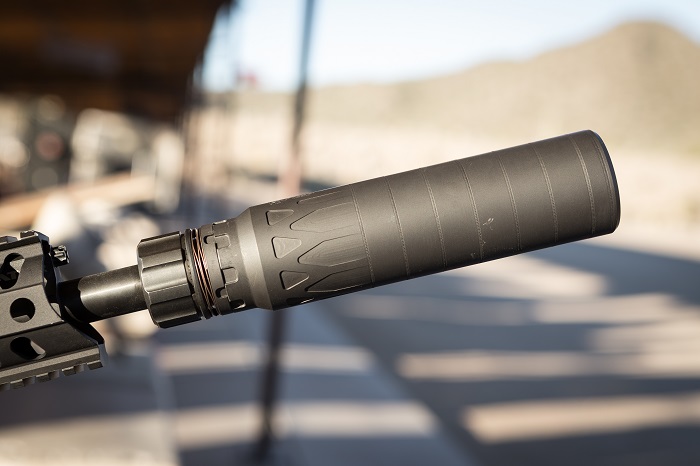Photos by Tap Rack Bang Creative
Dead Air Armament® Sandman™ suppressors are highly regarded for their multi-platform capability, superb decibel reduction, low back pressure and impressive durability. But for the typical everyday shooter they are overbuilt. Most shooters don’t have the need for a suppressor designed for sustained full auto fire and the attendant weight and cost that go with it.
When selecting a sound suppressor/weapon system, a variety of factors need to be taken into consideration. These include the operational requirements in the mission in which it will be employed, any special ammunition requirements, cost, maintenance and any required modification to the weapon. Other considerations include point of impact (POI) shift between suppressed and unsuppressed, construction, back-pressure and thread-on vs. a quick attachment system.
Dead Air Nomad-30
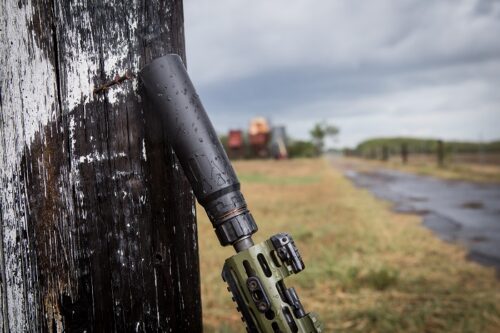
Mike Pappas, Founder of Dead Air Armament and Director of New Product Development, set out to further the legacy of the Sandman series with a new lightweight suppressor designed specifically for the everyday user. The Dead Air Nomad-30 is that suppressor. It is, in the words of the company, designed to go everywhere you go, mounted on whatever rifle suits you job for the day. The Nomad is rated up to .300 Norma Mag and .300 Rem Ultra with the direct thread mount and to .300 Win Mag with the Key-Mo adapter, with no barrel length restrictions. It is lightweight, versatile and modular.
The Nomad weighs in at just 14 ounces. It features laser-welded tubeless17-4 PH stainless steel construction with Grade 5 titanium 5/8×24 direct thread mount back cap and front cap insert. The direct thread mount is easily interchanged with a Key-Mo adapter that allows the Nomad to be used with any Dead Air muzzle device. The front cap takes all Sandman cap inserts and the Nomad Enhanced Brake (E-Brake™).
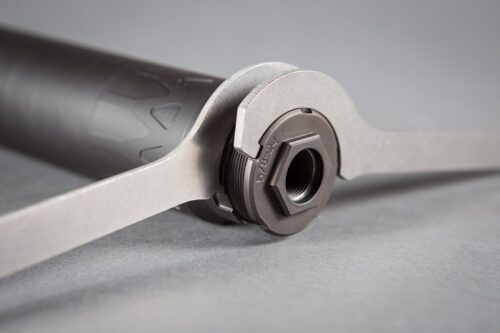
A direct thread mount is the strongest, most precise method of mounting a suppressor. Thread mount suppressors re generally more accurate and less prone to alignment issues and baffle strikes, although thread mount suppressors can work themselves loose and out of alignment. Thread mount suppressors are widely used on precision rifles.
The Key-Mo adapter does have advantages over a thread mount for certain applications. It allows end user to more easily switch the suppressor between different weapon platforms, although they generally it does require the use of proprietary mounts.
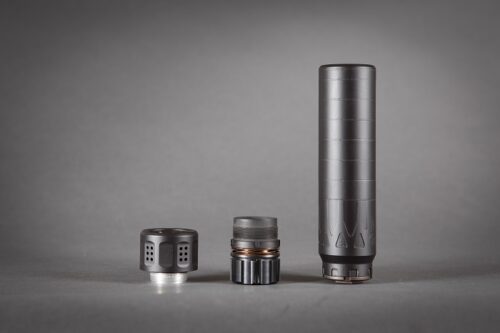
The 17-4 PH stainless steel construction of the Nomad offers the best balance of high-strength, erosion resistance, heat tolerance, heat transfer and cost for a suppressor that will not be employed in a sustained high-volume fire role. 17-4 PH is a martensitic, chromium-nickel-copper precipitation-hardening stainless steel. It is capable of attaining a wide range of strength and toughness properties depending on the precipitation or aging temperature used in hardening. It is more than capable of handling law enforcement applications and the most rigorous training courses.
The Grade 5 titanium thread mounts and front cap insert keep the weight down while providing superior temperature and wear resistance. Grade 5 titanium is an alloyed titanium and is considered to be an alpha-beta alloy. It is alloyed with 6% aluminum and 4% vanadium and is commonly known as Ti 6Al-4V. Despite being lightweight, it has great strength and additionally has outstanding corrosion resistance.
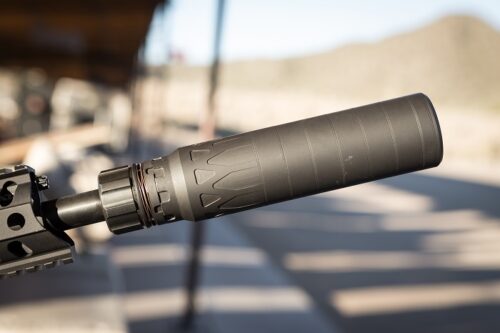
Suppressor baffles are under extreme stress and the materials that are utilized must be matched to the application. The Nomad utilizes a newly designed dual-baffle system. The17-4 PH stainless steel baffles feature a high-efficiency baffle design that provides the optimal balance of muzzle report performance, minimal first round pop, and reduced system back pressure.
Suppressing a weapon can significantly increase back-pressure. Excessive back-pressure will increase the cyclic rate, causing weapon malfunctions, reduce the service life of the weapon, spit gasses back into the face of the operator, and cause increased fouling. The back-pressure created by traditional suppressors can be eliminated to a great degree by suppressors designed to control the gasses rather than simply trap them.
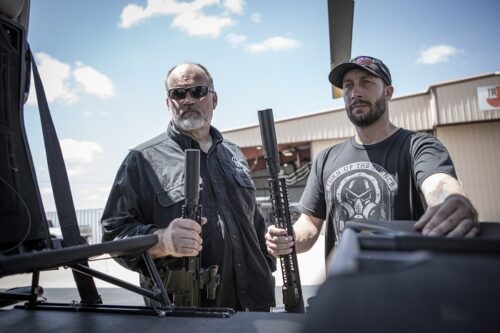
Although many variables come into play, suppressors, such as the Nomad, with improved gas flow dynamics can also largely eliminate the first round pop (FRP) and flash common with traditional designs. With traditional suppressors, the first round is often louder than subsequent rounds and there may be a slight flash. This results from the oxygen that’s initially in the suppressor burning off, making the first round louder than subsequent shots. It is more noticeable on low-pressure calibers. Use of an artificial environment will also largely eliminate FRP and flash.
The Nomad utilizes a new 1.735-inch diameter body and surface milled features. The larger outer diameter offers lower back pressure, increased surface area for faster heat dissipation, and increased grip for tightening/loosening the suppressor. It also allows the suppressor to be shorter while maintaining the desired performance. The laser-welded construction provides optimal consistence with no thin-welded sections. Overall length is 6.5 inches with the direct thread mount.
As mentioned previously, the Nomad utilizes the same caps as the Sandman series. The Nomad is shipped with a 7.62 Grade 5 titanium cap installed on the suppressor. Although it is not required for shooting of different calibers, if you are looking to maximize sound performance for a specific caliber, simply pick up a cap in the desired caliber and a removal tool. Dead Air offers 5.56, 6.5 and 7.62 caps. Dead Air also offers 5.56 and 7.62 flash hider caps and the aforementioned E-brake for the suppressor.
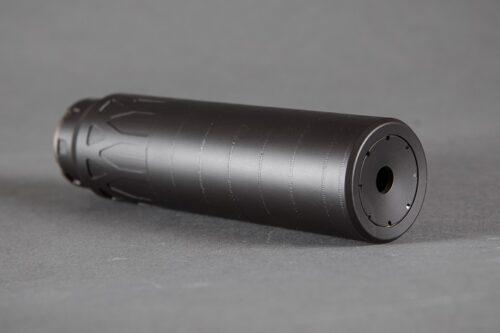
The body of the Nomad has an attractive matte black high-temperature Cerakote® ceramic coating. Originally developed for use on automobile headers and now used widely in the firearms industry, Cerakote is a high quality, long lasting thin-film ceramic finish that provides extreme hardness, outstanding abrasion resistance, superior durability and excellent corrosion protection.
Any comparisons between suppressors need to be carefully considered, since the method of testing that’s utilized by manufacturers may vary from manufacturer to manufacturer, making comparisons difficult, unless one has all of the details as to how the testing was conducted. Dead Air Armament tests all of its suppressors to MIL-STD-1474C, the US military standard for testing suppressors.
The Science of Silence
There are three possible sources of sound from the discharge of a firearm that need to be considered when silencing a firearm: the weapon’s report, i.e., muzzle blast; the ‘crack’ caused by a supersonic bullet passing the sound barrier; and the sound from the cycling of the firearm’s action. The muzzle blast is the most significant source of sound that’s generated by a firearm.
Muzzle blast is the consequence of the shock waves resulting from high-pressure gases exiting the barrel. If the pressure is reduced immediately before it exits, the weapon’s report will be reduced. All suppressors make use of the Combined Gas Law or General Gas Equation, which is the relationship between the pressure, volume, and temperature for a fixed mass (quantity) of gas.
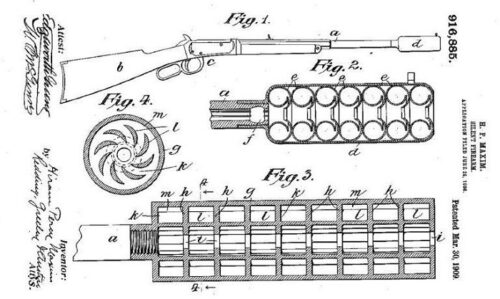
Muzzle blast is also reduced by decreasing velocity of the gases and either absorbing the sound waves or canceling them by interference with reflected waves coming from the same source.
Sound waves behave in many ways similar to light waves. As with light waves, sound waves can be reflected, refracted, diffracted and scattered. Various combinations of components, such as baffles, spacers, packing material, mesh, expansion chambers, spiral diffusers, pressure relief ports, and wipes may be employed in a suppressor to ‘silence’ a firearm.
As a suppressor accumulates fouling during firing, its effectiveness will deteriorate. The maintenance requirements will differ depending on the suppressor. Some baffled systems require dunking in solvent to clean out the fouling. Other designs may require repacking or the replacement of ‘wipes’ at the factory. It should be noted that silencer parts fall under provisions of the NFA. The Nomad has been designed to be self cleaning and maintenance free.
Muzzle sound suppressors such as the Nomad are more versatile than integral suppressors, in that they can easily be removed when sound suppression is not necessary. If subsonic ammunition is employed, muzzle suppressors are often every bit as quiet as an integral suppressor. Because they do not reduce the velocity of a bullet, higher terminal velocities are possible for applications in which a sonic crack is not an important tactical consideration.
When you put on or take off a suppressor, you typically will see some POI shift. A barrel is essentially a cantilevered beam. Anytime you put a weight on the muzzle you will see some POI shift. With any suppressor, POI shift will vary from platform to platform.
There are two types POI shift when mounting a suppressor and POI shift from shot to shot. POI shift when mounting a suppressor is more impacted by the threads on the weapon than the suppressor. POI shift is not as much of an issue if it is repeatable as the shooter can easily correct for the shift. POI shift from shot to shot is most often related to the mounting system of a quick attach suppressor.
At the Range with the Nomad-30
I recently met up with a Dead Air company rep for some range time with the Nomad at the Rio Salado Sportsman’s Club outdoor range, located in Mesa, Arizona. A .300 BLK “Frankengun” DI (Direct Impingement) AR pistol with 10.5-inch barrel and Maxim Defense CQB Pistol Brace and a POF-USA .308 Win. Revolution DI rifle with 16.5-inch barrel were brought along for use with the suppressor. The Revolution DI is a relatively new addition to POF-USA Revolution line.
The Nomad was tested with both the direct thread mount and the Key-Mo adapter. The .300 BLK Frankengun utilized the Nomad thread mount. The .308 Revolution was equipped with a Dead Air muzzle brake and utilized the Nomad with the Key-Mo Adapter to quick attach the suppressor. Atomic Ammunition 220-grain HPBT .300 BLK Subsonic and 175-grain HPBT .308 Win Subsonic was utilized for testing.
When I removed the Nomad from its case I was immediately impressed with its light weight and compactness, as well as it’s obvious build quality. The visual aesthetics of the surface milled features in conjunction with the matte black Cerakote finish were outstanding.
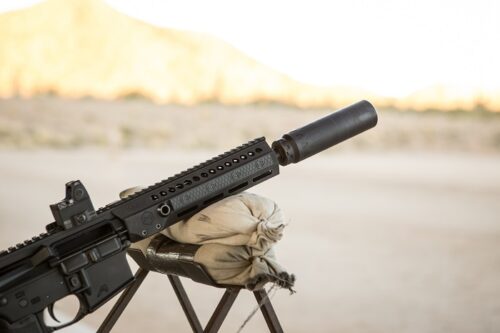
The Nomad was initially installed on the Frankengun. Performance with the subsonic .300 BLK was stellar. The sound levels were definitely within the hearing safe range and had a pleasing throaty sound. There was no noticeable blow-back, although admittedly we were outdoors with a slight breeze.
We then switched the Nomad over to the Key-Mo mount for use with the Dead Air muzzle brake on the Revolution. It took only seconds using the two hook spanner wrenches that come with the Nomad. Mounting of the suppressor on the gun was equally quick.
The Key-Mo mount provides a very secure lockup. To remove the suppressor with the Key-Mo adapter installed, you simply rotate the body counterclockwise 1/4 turn, at which point it will stop turning and you then simply pull the suppressor off the brake or flash hider.
Although we didn’t put enough rounds down range to verify, I am told the Dead Air Key-Mo mounting system is not prone to locking up with fouling with extensive shooting as is the case with some quick-detach system. No strap wrench will be necessary.
Performance of the Nomad was equally stellar with the .308 subsonic stellar, although as was expected the gun didn’t cycle with this round. This is specialty ammunition and is not specifically designed to cycle semi- or fully-automatic weapons.
Changing front caps or replacing the end cap with the E-Brake proved exceptionally easy. You simply align the pins in the front cap tool with the holes in the end caps and turn it counter clockwise to remove the caps. And a cool feature is you can store the front cap that is not being used on the front cap tool. Itself.
According to Dead Air using the correct size front cap for 5.56 or 6.5 calibers will provide an additional four to five dB reduction but obviously care must be taken not to use a smaller caliber front cap with a larger caliber firearm. The E-Brake is designed for the Nomad to help mitigate recoil. Although it can be used with the Dead Air Sandman series, Dead Air Wolverine PBS-1 and Dead Air Pyro Enhanced Muzzle Brake, it is best suited for use with the Nomad.
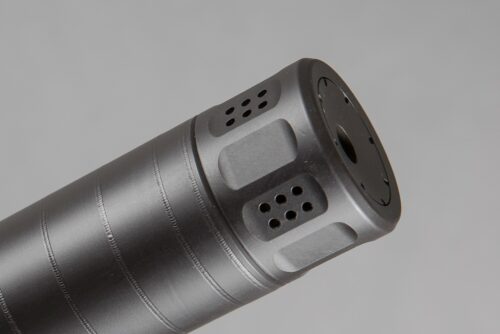
Although perceived recoil is somewhat subjective, the E-Brake did seem to soften it even further, although the subsonic rounds we were using are hardly heavy recoiling. And an added plus is that it seemed to us us reduce the dB level even further as perceived by the shooter.
To sum it all up, the Nomad is an outstanding suppressor that will meet all the needs of most shooters and do so at a more affordable price. The modular design offers maximum versatility for use with multiple weapon platforms.
The Nomad ships with a Dead Air vinyl sticker, two (2) hook spanner wrenches and a hard-sided case. It is covered by a lifetime warranty. MSRP is $916.00.
Ratings
Cost: 5/5
Durability: 5/5
Functionality: 5/5
Weight: 4/5
Overall Rating: 19/20
SPECIFICATIONS
DEAD AIR ARMAMENT NOMAD-30
MANUFACTURER: Dead Air Armament
MODEL: Nomad-30
WEIGHT: 14 ounces
LENGTH: 6.5 inches
DIAMETER: 1.735 inches
INSTALLED MOUNT: 5/8×24 Direct Thread
BUILD MATERIALS: 17-4 Stainless Steel & Grade 5 Titanium
FINISH: Matte Black Cerakote
RATING: Direct Thread to .300 Norma Mag & .300 Rem Ultra Mag; Key-Mo to .300 Win Mag
MINIMUM BARREL LENGTH: No Restrictions
WARRANTY: Lifetime
MSRP: $916.00
PERFORMANCE
Caliber Nomad-30 Omega-30 (Reference) Nomad30 w/E-Brake
5.56×45 134.7 dB 135.5 dB 131.8 dB
7.62×51 137.1 dB 138.0 dB 135.8 dB
300 BLK 126.7 dB 127.5 dB 124.9 dB
TEST EQUIPMENT: G.R.A.S. 0.25-inch Pressure Microphone Type 40BD // G.R.A.S. 0.25-inch CCP Preamplifier Type 26CB // National Instruments NI USB-4432 – DAQ 102.4 kS/s, 24 Bits, ± 40V, IEPE // National Instruments – LabVIEW Software.
Tested in accordance with MIL-STD-1474C
I was provided with this product on loan as a courtesy from the manufacturer so I could test it and give my honest feedback. I am not bound by any written, verbal, or implied contract to give this product a good review. All opinions are my own and are based off my personal experience with the product.
*The views and opinions expressed on this website are solely those of the original authors and contributors. These views and opinions do not necessarily represent those of Spotter Up Magazine, the administrative staff, and/or any/all contributors to this site.”
